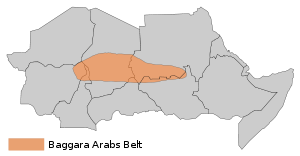Humur
The (Misseriyya) Humr ( variant spelling - Humur, an Arabic word for red ), is one of two tribes in the Messiria ( better transliteration - Misseriyya ) branch of the Hawazma tribe, itself a subgroup of the Baggara, ( Arabic : cowmen, with variant spelling Baqqārah ) ethnic grouping, native to the southwest of the former province of Kordofan in Sudan. Speakers of Shuwa or Chadian Arabic, the Humur live in the area surrounding the cities of Babanusa, Muglad and Alfoula ( variant spelling on Google Earth 'El Fula' ). They are divided into two groups. The Ajaira, who live in the area from Muglad to Abyei ( see also Abyei (town) ) and the Felaita ( variant spelling : Falita ), who live in the vicinity of Babanusa, Alfoula and Kajira. There are six ( seven ? ) clans in the Ajaira and five in the Falita, and thus twelve ( eleven ? ) Humrawi clans in all. Ian Cunnison lists the clans of the two divisions of the Humr thus:
Ajaira : 1.) Fayyarin 2.) Awlád Kamil 3.) Mezaghna 4.) Fadliya 5.) Menama 6.) 'Addal
Felaita : 1.) Metanin 2.) Ziyud 3.) Awlád Serur 4.) Jubarat 5.) Salamat[1]
The Nathir ( Arabic 'he who warns' ( = leader )) of the Ajaira is currently Ali Nimr, while the Nathir of the Falita is currently Abdul Elmonim Alshowein.
Hunting
The Humur have long been intrepid hunters of the elephant and the giraffe. Humrawi hunters have been recorded as saying that their main reason for hunting the giraffe is the preparation of the drink umm nyolokh.[2]
Giraffe Liver Drink umm nyolokh
1.jpg)
_p454_Planche_VIII.jpg)
The Humur have attained a measure of fame outside the Sudan as the preparers of a remarkable ( non-alcoholic ) drink made from the liver and bone marrow of the giraffe, which they call umm nyolokh, and which they claim is intoxicating ( Arabic سكران sakran ), causing dreams and even waking hallucinations. If substantiated by chemical analyses of the drink in question, this claim would make the giraffe the first mammal to be discovered to contain a hallucinogen in its bodily tissues, and the Humrawi the first people to have discovered the existence of such a mammal.[3] Anthropologist Ian Cunnison, who accompanied the Humr on some of their giraffe-hunting expeditions in the late 1950s, notes that:
It is said that a person, once he has drunk umm nyolokh, will return to giraffe again and again. Humr, being Mahdists, are strict abstainers [ from alcohol ] and a Humrawi is never drunk ( sakran ) on liquor or beer. But he uses this word to describe the effects which umm nyolokh has upon him.[2]
Cunnison's remarkable account of an apparently psychoactive mammal found its way from a somewhat obscure scientific paper into more mainstream literature through a conversation between Dr. Wendy James of the Institute of Social and Cultural Anthropology at the University of Oxford and specialist on the use of hallucinogens and intoxicants in society Richard Rudgley, who considered its implications in his popular work The Encyclopedia of Psychoactive Substances. Rudgley hypothesises that the presence of the hallucinogenic compound DMT might account for the putative intoxicating properties of umm nyolokh.[3]
Cunnison himself, on the other hand, had found it hard fully to believe in the literal truth of the Humr's assertion that their drink was intoxicating:
I can only assume that there is no intoxicating substance in the drink and that the effect it produces is simply a matter of convention, although it may be brought about subconsciously.[2]
The study of entheogens in general - including entheogens of animal origin ( e.g. hallucinogenic fish and toad venom ) - has, however made considerable progress in the sixty-odd years since Cunnison's report and the idea that some intoxicating principle might reside in giraffe liver no longer seems as far-fetched as it did in Cunnison's day, although conclusive proof ( or disproof ) will have to await detailed analyses of the animal organ in question and the drink prepared from it.[3]
References
- Cunnison, Ian 1966, Baggara Arabs, Power and the lineage in a Sudanese Nomad Tribe, Clarendon Press.
- Cunnison, Ian 1958 Giraffe Hunting among the Humr Tribe, SNR 39, pps. 49-60.
- Rudgley, Richard The Encyclopedia of Psychoactive Substances , pub. Abacus 1998 ISBN 0 349 11127 8 pps. 20-21.
